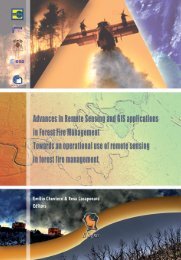EARSeL Newsletter - EARSeL, European Association of Remote ...
EARSeL Newsletter - EARSeL, European Association of Remote ...
EARSeL Newsletter - EARSeL, European Association of Remote ...
You also want an ePaper? Increase the reach of your titles
YUMPU automatically turns print PDFs into web optimized ePapers that Google loves.
<strong>EARSeL</strong> <strong>Newsletter</strong> September 2002 - Number 51<br />
10<br />
the <strong>European</strong> Space Incubators Network<br />
(ESINET), launched this summer by the<br />
<strong>European</strong> Space Agency (ESA) and the <strong>European</strong><br />
Commission (EC). It is Europe’s<br />
first network <strong>of</strong> space business incubation<br />
centres, and at present includes 20 incubators<br />
in twelve <strong>European</strong> countries. With<br />
33,000 employees and an annual turnover<br />
<strong>of</strong> 5.5 billion, the space sector generates<br />
many technologies and systems, which can<br />
be used by entrepreneurs to develop new<br />
products and new value-added services for<br />
use in the non-space sectors.<br />
Business incubators are committed to nurturing<br />
entrepreneurs, start-ups and small<br />
companies at an early stage in their ventures.<br />
They <strong>of</strong>fer access to finance, <strong>of</strong>fice<br />
space and logistics, hands-on advice and<br />
management assistance, help with recruitment<br />
and marketing, and <strong>of</strong>fer support for<br />
legal aspects and services, etc. Bruno<br />
Naulais continued: "It is a tough challenge<br />
to get from a good idea to having a company<br />
running successfully. Thanks to the<br />
support <strong>of</strong> ESINET, start-ups should significantly<br />
increase their survival rate."<br />
ESA is supporting ESINET, a <strong>European</strong> network,<br />
rather than a few national incubators,<br />
since such a network falls nicely into<br />
the frame <strong>of</strong> the ESA-EC common strategy<br />
for space. Furthermore, a recent EU benchmark<br />
study showed that the rate <strong>of</strong> success<br />
<strong>of</strong> stand-alone incubators is lower and is,<br />
therefore, less attractive to entrepreneurs.<br />
ESINET includes 20 incubators in Belgium,<br />
Bulgaria, Finland, France, Germany, Italy,<br />
Netherlands, Portugal, Spain, Sweden, the<br />
UK and the Ukraine.<br />
For more information about ESINET, contact:<br />
Bruno Naulais, <strong>European</strong> Space Incubators<br />
Network Manager, Technology<br />
Transfer and Promotion Office, <strong>European</strong><br />
Space Agency – ESTEC, Keplerlaan 1, PO<br />
Box 299, 2200 AG Noordwijk, The Netherlands<br />
(telephone: +31-71-5654711; fax: +31<br />
71 565 3854; e-mail:bruno.naulais@esa.int;<br />
web: www.esa.int/technology).<br />
3.1.4 ESA’s New Media Support<br />
Centre (NMSC)<br />
The New Media Support Centre (NMSC),<br />
an ESA initiative, <strong>of</strong>fers a basis for innovation<br />
and cross-fertilisation <strong>of</strong> ideas. It will<br />
provide the support which businesses and<br />
institutions need to manage the risk <strong>of</strong> exploring<br />
new cross-discipline satellite technology.<br />
To learn more about the NMSC and<br />
express your interest in their facilities, visit<br />
the NMSC web-site and fill in the on-line<br />
questionnaire.<br />
Applications support has been the starting<br />
point <strong>of</strong> NMSC operations. NMSC is now<br />
providing access to a number <strong>of</strong> basic facilities<br />
such as satellite capacity, satellite<br />
networks, terminals, a demonstration laboratory<br />
for real-time or <strong>of</strong>f-line demonstration<br />
<strong>of</strong> applications and technical support<br />
in the use <strong>of</strong> NMSC facilities. New capabilities<br />
will be added over time. Particular<br />
emphasis will be given to providing Systems<br />
Simulations and satellite Terminals<br />
Testing facilities. By filling in the NMSC<br />
on-line questionnaire, potential users can<br />
help the NMSC fine-tune their facilities to<br />
meet user needs and market developments.<br />
The test and development environment <strong>of</strong>fered<br />
by the NMSC is for services, applications<br />
and equipment combining any <strong>of</strong> the<br />
traditional telecommunications disciplines<br />
(multimedia, mobile or broadcast), navigation<br />
and Earth imaging, which employ<br />
satellite communications in some form.<br />
Some <strong>of</strong> the uses envisaged include telemedicine,<br />
tele-education, advanced satellite<br />
networks and satellite-based emergency<br />
management systems. Read more at:<br />
www.esa.int/export/esaSA/ESAKS0KE43<br />
D_telecom_0.htm.<br />
3.2 News from the EC<br />
3.2.1 Monitoring Agriculture with RS:<br />
news update<br />
Guido Lemoine, JRC, Institute for Protection<br />
and Security <strong>of</strong> the Citizen, Ispra, Italy (e-mail:<br />
guido.lemoine@jrc.it)<br />
With the eighth successive campaign coming<br />
to its end, the "Control with <strong>Remote</strong><br />
Sensing" programme <strong>of</strong> the EU’s MARS<br />
(Monitoring Agriculture with <strong>Remote</strong><br />
Sensing) project remains a mainstay in
















